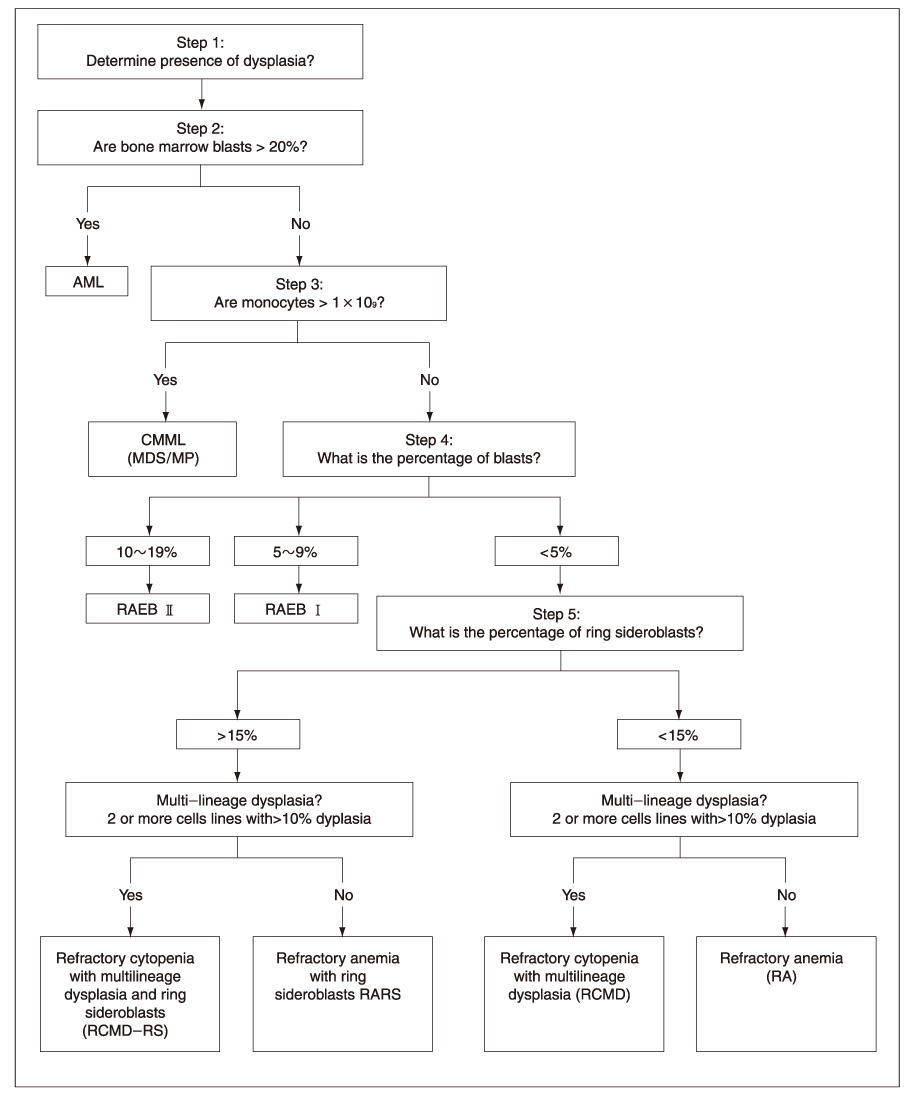J Korean Med Assoc.
2006 Oct;49(10):897-907. 10.5124/jkma.2006.49.10.897.
Myelodysplastic Syndrome
- Affiliations
-
- 1Department of Internal Medicine, Yonsei University College of Medicine, Korea. jwcheong70@yumc.yonsei.ac.kr
- KMID: 2064969
- DOI: http://doi.org/10.5124/jkma.2006.49.10.897
Abstract
- Myelodysplastic syndrome (MDS) is a clonal stem cell disorder characterized by ineffective hematopoiesis, multilineage dysplasia, peripheral cytopenias with normocellular or hypercellular marrow, and susceptibility to leukemic transformation. MDS represents a heterogenous group of disorders with a wide spectrum of clinical, morphological, biologic, and genetic characteristics. MDS is classified according to the World Health Organization criteria and the International Prognostic Scoring System. Risk-adapted treatment strategies have been developed in consideration of the advanced age of patients and to improve the clinical course of the disease. The pathophysiology, cytogenetic/molecular profiles, clinical characteristics and treatment modalities according to the prognostic groups will be described. In the future, a combination of treatment modalities to increase gene reactivation and to take advantage of increased expression of target genes may be critical to improve clinical outcomes. Multiple pathways may be involved in the MDS phenotype, and combination therapies, including novel agents, may be required to make further progresses in the treatment of this disease.
MeSH Terms
Figure
Reference
-
1. Steensam DP, Bennett JM. The myelodysplastic syndromes: diagnosis and treatment. Mayo Clin Proc. 2006. 81:104–130.
Article2. List AF, Vardiman J, Issa JP, DeWitte TM. Myelodysplastic syndrome. Hematology Am Soc Hematol Educ Program. 2004. 297–317.3. Noel P, Solberg LA Jr. Myelodysplastic syndromes. Pathogenesis, diagnosis and treatment. Crit Rev Oncol Hematol. 1992. 12:193–215.4. Nishino HT, Chang CC. Myelodysplastic syndromes: clinicopathologic features, pathobiology, and molecular pathogenesis. Arch Pathol Lab Med. 2005. 129:1299–1310.
Article5. Bennet JM, Komrokji RS. The myelodysplastic syndrome: diagnosis, molecular biology and risk assessment. Hematology. 2005. 10:suppl 1. 258–269.
Article6. Brunning RD, Head D, et al. Jaffe S, Harris NL, editors. Myelodysplastic syndromes. World Health Organization Classification of Tumors; Tumors of Haematopoietic and Lymphoid Tissues74. 2001. Lyon: IARC press;61–74.7. Korean Society of Hematology. Hematology. 2006. 1st ed. Seoul: E-Public;265–275.
- Full Text Links
- Actions
-
Cited
- CITED
-
- Close
- Share
- Similar articles
-
- Sweet's Syndrome with Myelodysplastic Syndrome Progressing to Acute Myelogenous Leukemia
- Classifications and prognostic scoring systems in myelodysplastic syndrome
- Unusual Cutaneous Neutrophilic Infiltration in Myelodysplasia Syndrome : A Nuclear Segmentation Anomaly
- A Case of Subcutaneous Sweet's Syndrome in MYelodysplastic Syndrome Showing Nuelear Segmentation Anomalies of Neutrophils
- Langerhans Cell Histiocytosis Associated with Myelodysplastic Syndrome


